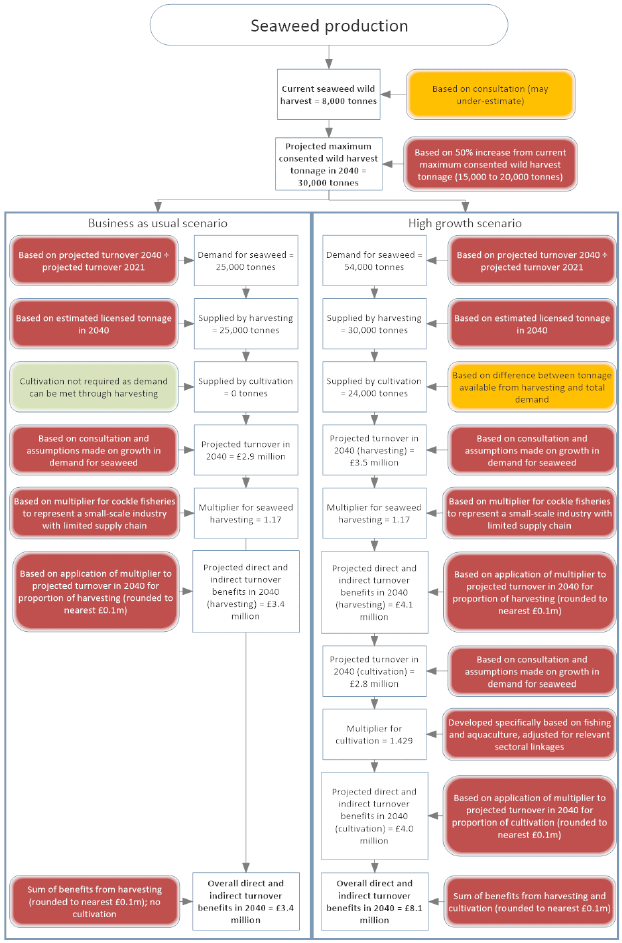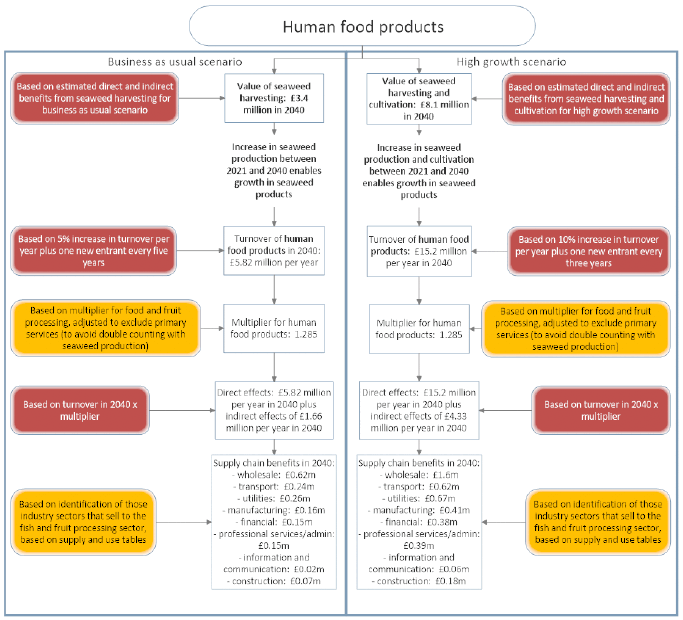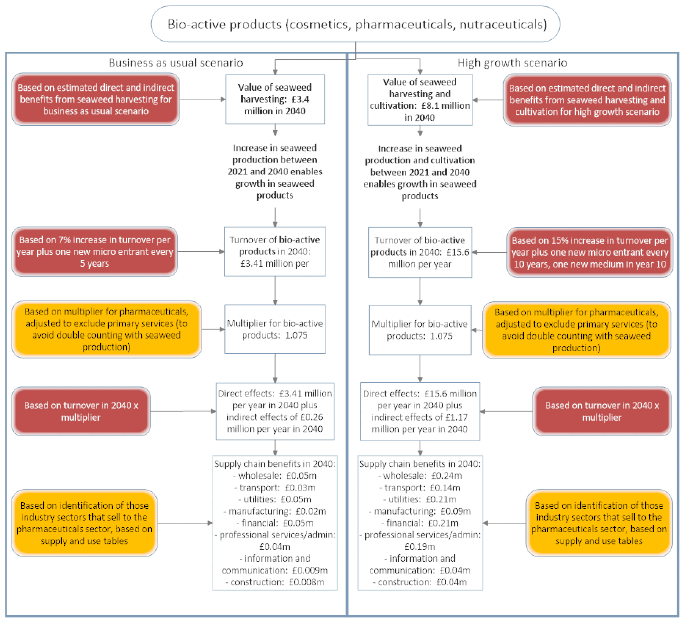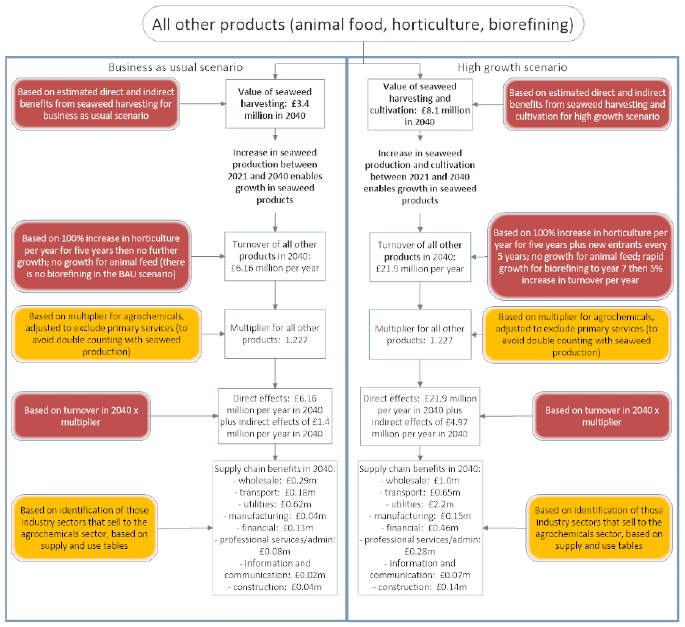Potential scale of Scottish seaweed-based industries: research paper
This report provides an assessment of the current status and future growth opportunities for Scottish seaweed-based industries. It includes a scenario analysis that explores the key areas of growth for the seaweed sector and the wider economic and social impacts of possible growth scenarios.
7 Potential economic impact on supply chains under the projected future scenarios
7.1 Overview
7.1.1 This section provides an analysis of the economic impacts on the seaweed-based industry (direct impacts), and its supply chain (indirect effects). Thus, the impacts on seaweed harvesting and production businesses, and the impacts on the associated upstream and downstream supply chain companies are incorporated under the different scenarios (BAU and higher growth projected future scenarios) described in Section 6.
7.1.2 Whilst the complete methodology used to estimate turnover impacts for the seaweed industry and its supply chain is set out in Appendix F (Sections F.2 and F.3), a brief summary is presented here. Under both scenarios (presented in Section 6), projected turnover for the industry has been estimated up to the year 2040. Output multipliers have been used to estimate direct and indirect output for the industry and its supply chain. Furthermore, the breakdown of supply chain benefits has been estimated. Specifically, the multipliers capture:
- Direct effects: When there is an increase in final demand for a product, the equivalent increase in turnover is referred to as the direct effect;
- Indirect effects: To meet the increase in demand for final products, firms will need resources and services from their supply chains, the increase in turnover for firms along the supply chain is referred to as the indirect effect; and
- Total effects: represents the total impact on the industry and comprises both direct and indirect effects.
7.1.3 This section presents the results of applying output multipliers to projected turnover under both scenarios. Whilst many firms are vertically integrated businesses, the analysis has separated businesses who produce seaweed (i.e harvesting and cultivation) and businesses who produce seaweed-based products (e.g. human food products). The separation enables the estimation of benefits along the whole supply chain. In practice, many of these firms are one and the same and as such various steps have been undertaken to avoid double counting, for more detail see Appendix F (Sections F.2 and F.3).
7.2 Direct and indirect benefits: turnover
Seaweed production
Under the BAU scenario:
- Total turnover for seaweed production and its supply chain is estimated to increase from £1.1 million in 2021 to £3.4 million in 2040. This is comprised of wild seaweed harvesting with turnover from seaweed producers (direct effect) increasing from £930,000 in 2021 to £2.9 million in 2040; and businesses in the supply chain increasing turnover from £160,000 in 2021 to £500,000 in 2040 (indirect effect).
Under the Higher Growth scenario:
- Total turnover for seaweed production and its supply chain is expected to increase from £1.1 million in 2021 to £8.1 million in 2040. This is comprised of both wild seaweed harvesting and cultivation. For wild harvesting, production turnover is expected to increase from £930,000 in 2021 to £3.5 million in 2040 (direct effect); whilst supply chain turnover is expected to increase from £160,000 in 2021 to £590,000 in 2040 (indirect effect). For cultivation, turnover is expected to increase from £0 in 2021 to £2.8 million in 2040; whilst supply chain turnover is expected to increase from £0 in 2021 to £1.2 million in 2040.
7.2.1 Table 17 summarises the results under both scenarios for 2040. Detailed, year by year estimates are provided in Appendix G.
| Production type |
Effect |
2040 |
|
|---|---|---|---|
| BAU |
Higher growth |
||
| Harvesting |
Direct effect |
£2.9 million |
£3.5 million |
| Indirect effect |
£0.5 million |
£0.59 million |
|
| Cultivation |
Direct effect |
N/A |
£2.8 million |
| Indirect effect |
N/A |
£1.2 million |
|
| Total |
£3.4 million |
£8.1 million |
|
Rounding may lead to figures not summing exactly in some cases.
7.2.2 Figure 6 summarises the calculation for seaweed production for the BAU and Higher Growth scenarios.
7.2.3 The flowchart sets out the steps in the calculation as well as the assumptions made. The assumptions are coded using a RAG (red-amber-green) system to indicate the degree of uncertainty introduced into the calculations (red=high; amber=moderate; green=low). It is important to remember that the calculations are based on scenarios, which are projections into the future so will have a high degree of uncertainty at most points during the calculation.

Seaweed-based products
7.2.4 Seaweed-based products have been divided into three main categories: human food, bio-actives (cosmetics, pharmaceuticals and nutraceuticals) and all other products (animal food, horticulture and biorefining (the latter in the higher growth scenario only)). The results presented here summarise the impacts on turnover across all of the product ranges and their supply chains.
7.2.5 It should be noted that determining the link between the value of seaweed production in 2040 (wild harvesting and cultivation) and the value of seaweed-based products in 2040, in terms of which products will use wild harvested or cultivated seaweed, was not possible in this study. This is due to the uncertainty regarding the proportion of wild harvested vs cultivated seaweed that operational business would choose to incorporate into their products in 2040, which in turn would depend on other factors, for example, the cost of cultivated seaweed in 2040 and the structure of the industry in 2040 (e.g. whether companies are vertically integrated and use their own wild harvested or cultivated seaweed for in-house production of seaweed-based products).
Under the BAU scenario:
- Total turnover from seaweed-based products and the supply chain is expected to increase from £6 million in 2021 to £18.7 million in 2040. This is comprised of turnover for business who produce seaweed-based products increasing turnover from £4.9 million in 2021 to £15.4 million in 2040; with supply chain business are estimated to increase turnover from £1.1 million in 2021 to £3.3 million in 2040. By type of product, turnover in 2040 is:
- Human food: £5.82 million for producers of human food products and £1.66 million for supply chain businesses in 2040
- Bio-actives: £3.41 million for producers of bio-actives and £0.26 million for supply chain businesses in 2040
- All other products: £6.16 million for producers of animal food and horticulture and £1.4 million for supply chain businesses in 2040
Under the higher growth scenario:
- Total turnover from seaweed-based products and the supply chain is expected to increase from £6.2 million in 2021 to £63.1 million in 2040. This is comprised of turnover for business who produce seaweed-based products increasing turnover from £5 million in 2021 to £52.6 million in 2040; with supply chain business are estimated to increase turnover from £1.2 million in 2021 to £10.5 million in 2040. By type of product, turnover in 2040 is:
- Human food: £15.2 million for producers of human food products and £4.33 million for supply chain businesses in 2040
- Bio-actives: £15.6 million for producers of bio-actives and £1.17 million for supply chain businesses in 2040
- All other products: £21.9 million for producers of animal food, horticulture and biorefining and £4.97 million for supply chain businesses in 2040.
7.2.6 Table 18 summarises the findings under both scenarios for the year 2040. Year by year estimations can be found in the technical annex.
7.2.7 Figure 7 summarises the calculation for seaweed products, covering human food, with Figure 8 covering bio-actives and Figure 9 summarising the calculations for all other products (animal food, horticulture and biorefining (the latter in the higher growth scenario only)).
| Production type |
Effect |
Turnover in 2040 (£ million) |
|
|---|---|---|---|
| BAU |
Higher Growth |
||
| Food |
Direct effect |
£5.82 |
£15.2 |
| Indirect effect |
£1.66 |
£4.33 |
|
| Bio-actives |
Direct effect |
£3.41 |
£15.6 |
| Indirect effect |
£0.26 |
£1.17 |
|
| All other products |
Direct effect |
£6.16 |
£21.9 |
| Indirect effect |
£1.4 |
£4.97 |
|
| Total |
Total direct effect (across all products) |
£15.4 |
£52.6 |
| Total indirect effect on supply chain businesses (across all products) |
£3.3 |
£10.5 |
|
| Total (Direct and indirect) | £18.7 |
£63.1 |
|
Rounding may lead to figures not summing exactly in some cases.



Contact
There is a problem
Thanks for your feedback